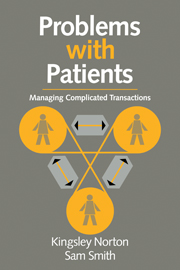Book contents
- Frontmatter
- Contents
- Foreword by Professor Paul Freeling, O.B.E.
- Preface
- Acknowledgments
- 1 Doctor–patient interaction
- 2 The clinical transaction
- 3 Interpersonal influences
- 4 The influence of past relationships
- 5 Contextual influences
- 6 Managing complicated clinical transactions
- 7 Interventions in complicated clinical transactions
- 8 Implications for the clinical setting
- 9 Implications for training
- Appendix I Clinical phenomena related to ‘problem patients’
- Appendix II Personality disorder
- References
- Index
Appendix II - Personality disorder
Published online by Cambridge University Press: 19 March 2010
- Frontmatter
- Contents
- Foreword by Professor Paul Freeling, O.B.E.
- Preface
- Acknowledgments
- 1 Doctor–patient interaction
- 2 The clinical transaction
- 3 Interpersonal influences
- 4 The influence of past relationships
- 5 Contextual influences
- 6 Managing complicated clinical transactions
- 7 Interventions in complicated clinical transactions
- 8 Implications for the clinical setting
- 9 Implications for training
- Appendix I Clinical phenomena related to ‘problem patients’
- Appendix II Personality disorder
- References
- Index
Summary
Definition
According to the International Classification of Diseases (WHO, 1992), personality disorder refers to conditions which comprise:
deeply ingrained and enduring behaviour patterns, manifesting themselves as inflexible responses to a broad range of personal and social situations. They represent either extreme or significant deviations from the way the average individual in a given culture perceives, thinks, feels and particularly relates to others. Such behaviour patterns tend to be stable and to encompass multiple domains of behaviour and psychological functioning. They are frequently, but not always, associated with various degrees of subjective distress and problems in social functioning and performance.
The other major classification scheme – Diagnostic and statistical manual of mental disorders(APA, 1987) – utilises very similar criteria. Thus, personality disorder is defined as:
behaviours or traits that are characteristic of the person's recent (past year) and long-term functioning (generally since adolescence or early adulthood). The constellation of behaviours or traits causes either significant impairment in social or occupational functioning or subjective distress. Behaviours or traits limited to episodes of illness are not considered in making a diagnosis of Personality Disorder.
Personality disorder subtypes
Subclassification is currently limited to the description of a series of types and subtypes that are not mutually exclusive and that overlap in some of their characteristics. In making a diagnosis of personality disorder, the clinician should consider all aspects of personal functioning, although the diagnostic formulation will refer only to those dimensions or traits for which suggested thresholds for severity are reached. The assessment should be based, ideally, on as many sources of information as possible.
- Type
- Chapter
- Information
- Problems with PatientsManaging Complicated Transactions, pp. 161 - 164Publisher: Cambridge University PressPrint publication year: 1994



